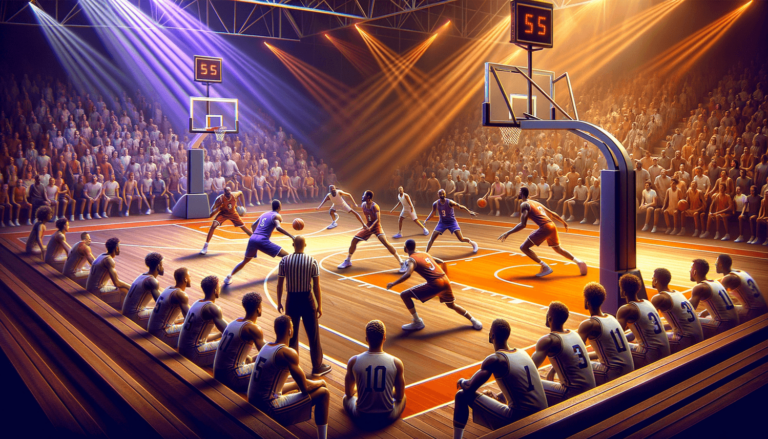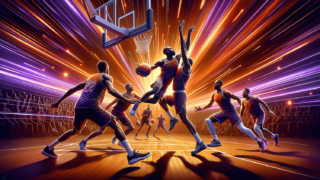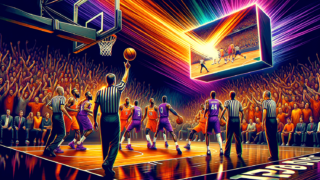
Delay of Game Technical Foul Rule in Basketball
Written by: Basketball Universe
Last updated:

Welcome hoop enthusiasts to our deep dive into the intricacies of the Delay of Game Technical Foul Rule in Basketball! In the ever-evolving world of this beloved sport, few details can make or break a game like this one. So strap in and prepare to become a master of this thin line between victory and defeat, as we unlock the mysteries of what exactly constitutes a delay of game technical foul, how it impacts the playing field, and how both players and refs expertly navigate this rule to maintain fair and thrilling competition.
Delay of Game Technical Foul Rule in Basketball
The Delay of Game Technical Foul Rule in Basketball is enforced when a player or team deliberately or excessively stalls the game’s progress. Actions that can result in a delay of game technical foul include preventing the opposing team from inbounding the ball, touching the ball after it passes through the basket, or even taking too long to; re-enter the court, shoot free-throws, or inbound the ball. The team committing the delay of game infraction is penalized with a warning for the first offense, and any subsequent violations result in a technical foul, awarding a free throw and possession to the opposing team.
Unraveling the Essence of Delay of Game Technical Foul
When watching basketball, you’ll often hear the announcer say that a team was given a warning for a delay of game, or sometimes, a technical foul is called for this reason. Many spectators are left wondering what that’s all about. In this in-depth exploration, we’ll dive into the various specific situations that fall under the delay of game technical foul umbrella and learn how to spot them on the court. Hopefully, this newfound knowledge will not only provide you with a greater understanding of basketball rules but also add some excitement to your viewing experience!
The Birth of the Delay of Game Rule
It’s important to understand how the delay of game rule has evolved over time. Initially, the rule was far more lenient and subjective, as officials were instructed to use their discretion to issue warnings and technical fouls if they felt a team was purposely prolonging the game. However, as basketball developed into a serious, competitive sport, there was a need for more specific and consistent rules to ensure fair play. Shifting from a discretionary approach to a set of clear guidelines was essential to erase ambiguity and maintain a level playing field. Let’s explore various specific scenarios that now result in a delay of game technical foul.
Obstruction: The Inbound Battle
Preventing Inbounds
An essential aspect of the delay of game technical foul rule is the moment when the ball has been awarded to a team, and an opposing player steps in-between the player attempting to throw it in and the court boundary. This act significantly delays the offensive team’s progress and violates the spirit of fair play. In these situations, officials will blow their whistle and issue a delay of game warning or technical foul, depending on whether it’s a first or repeated offense.
Disturbing the Offense
In addition to actively preventing inbounds, other forms of interference by defenders can result in a violation. Subtle acts such as tapping the ball away after it’s handed to the inbounder or swiping it out of his hands as he attempts to pass it in can lead to a delay of game warning or technical foul. The officials’ role is to create a fair and balanced environment for both offense and defense, and these sneaky tactics throw off that delicate equilibrium.
Free-Throw Fiasco
Disrupting the Free-Throw Shooter
During free-throw attempts, there’s a stringent time limit of 10 seconds for a shooter to release the ball. If a player disrupting the shooter breaches this limit, it’s considered delay of game. Instances where the shooter purposefully takes longer than allowed can also lead to a delay of game warning or a technical foul. Once the shooter receives the ball, all attempts to distract, harass, or otherwise interfere with his concentration are strictly prohibited and can result in penalties.
Violating Free-Throw Lane Position
Players are expected to maintain their positions within the designated free-throw lane during attempts. If players leaving their spots too early are caught, it could lead to a delay of game warning or a technical foul, as it unnecessarily prolongs the game and disrupts the free-throw shooter’s rhythm. For a smooth and uninterrupted contest, players must adhere to the boundaries and time constraints dictated by basketball rules.
After the Swish: Interactions with the Ball
Ball Retention Shenanigans
When a team scores a basket, players are expected to show restraint by not interfering with the ball. Touching the ball immediately after a made shot, irrespective of whether this action is accidental or intentional, can lead to a delay of game warning or a technical foul. In the interest of keeping the game moving, officials aim to minimize instances of unnecessary ball retention by penalizing violators.
Deliberate Ball Slapping
Another form of delay of game technical foul occurs when a player deliberately slaps the ball away from an opponent after a dead-ball situation. It may seem harmless or playful, but it disrupts the flow of the game and delays the opposing team’s opportunity to inbound the ball. Players must be mindful of their actions and maintain a sense of discipline and sportsmanship on the court.
Timeout Tardiness
Unpunctual Players
When a timeout is called, players must return to the court within a specified time or face penalties. Each player’s punctuality is crucial to the efficient running of the game. Repeatedly returning late from timeouts, whether by individual players or entire teams, can result in delay of game warnings or technical fouls. To avoid losing a precious point or possession, players must ensure they respect the clock and promptly return to action.
Substitution Struggles
Proper Substitutes
Substitution is a crucial aspect of basketball, as it allows coaches to implement their strategies and manage their players’ fatigue. However, issues can arise when players attempt to re-enter the game after being substituted without proper replacement. In such cases, officials will pull out their whistle and issue a delay of game warning or technical foul to keep things running smoothly.
Excessive Scenarios
Similarly, if a coach repeatedly sends in substitutes and causes excessive interruptions to the game flow, the officials are obliged to take action according to basketball rules. While it’s essential to allow some flexibility in managing lineups, a balance must be struck between strategic gameplay and fair competition. Excessive substitutions that bleed into deliberate game delays will earn the offending team a violation.
How Officials Uphold the Sanctity of the Game
Referees hold immense responsibility in maintaining the integrity and flow of basketball games. They must possess a detailed understanding of various rules, including those related to the delay of game technical foul. By observing and policing play, officials manage to keep the contest balanced and exciting, ensuring that neither team gains an unfair advantage over their opponents.
As spectators, understanding these rules enhances our appreciation of the sport and helps us decode the officiating decisions that shape the outcomes of basketball games. With this newfound mastery of the delay of game technical foul rule, you’ll be equipped tonavigate the complexities of the sport featured on the court, adding another layer of excitement to your basketball viewing experience!
Effect on Team Dynamics and Game Strategy
Another fascinating dimension of the delay of game technical foul rule is how it shapes the overall team dynamics and game strategy. Coaches and players often have to adapt to these circumstances by changing their approach, which, in turn, can significantly influence a game’s outcome. Let’s take a closer look at some tactics that may arise as a result of this rule.
Good Heads-Up Play
Basketball is a game of quick-thinking and reflexes, and understanding the delay of game technical foul rule is essential to sharpen those instincts. Sensing the right moment or reacting to an inbound, free-throw, or timeout scenario without violating the rule is a skill that can make a difference in a closely-contested match. The more aware and efficient players become in these situations, the better their team performs overall.
Preemptive Strategy
Coaches often prepare their teams to handle different scenarios related to the delay of game technical foul rule by running drills or discussing potential game situations during practice. By familiarizing the team with the rule, coaches can ensure that players are better equipped to react appropriately on the court. This preparedness allows the team to maintain focus and play more effectively, resulting in a higher chance of victory.
Exploiting the Rule
While this must be approached with caution, there can be strategic advantages to occasionally garnering a delay of game violation, particularly when the outcome doesn’t result in a technical foul. With a brief delay in play, players might gain a few extra seconds to catch their breath or coaches could have a chance to reassess their game plan. It’s important to note that this should never become a frequent tactic, as it not only goes against the spirit of the game but could also lead to costly technical fouls and subsequent penalties.
Overcoming the Dreaded Delay
In basketball, as in life, sometimes a challenge presents an opportunity for growth. The delay of game technical foul rule may seem daunting, but those who can harness it to their advantage will emerge as more well-rounded players and coaches. By understanding the ins and outs of this rule, teams and individuals can take steps to improve and refine their gameplay. And as fans, we can revel in the intricacies of a game that continues to evolve and inspire us all.
FAQ: Delay of Game Technical Foul Rule
Whether you’re new to basketball or a seasoned fan, specific rules and scenarios can be perplexing. Here, we’ve compiled a list of frequently asked questions related to the delay of game technical foul rule to satisfy your curiosity and help solidify your understanding of this vital facet of the game.
1. What’s the purpose of the delay of game technical foul rule?
The primary purpose of this rule is to maintain a smooth flow and a competitive balance of the game. It discourages tactics that slow down the game or disrupt opponents unfairly, ensuring an exciting match for spectators and a fair contest for both teams.
2. What types of actions can result in a delay of game violation?
Actions that may lead to delay of game violations include preventing the opposing team from inbounding the ball, touching the ball after it has passed through the basket, taking too long to re-enter the court, shoot free-throws or inbound the ball, or interfering with a free-throw shooter, among others.
3. What is the penalty for the first delay of game violation?
For the first delay of game violation, officials will issue a warning to the offending team. Any subsequent delay of game violations will result in a technical foul.
4. What is the penalty for a technical foul resulting from a delay of game violation?
The penalty for a technical foul due to a delay of game violation is the opposing team being awarded a free throw, and they will also gain possession of the ball.
5. Can a coach receive a delay of game technical foul?
Yes, a coach can receive a delay of game technical foul for excessive substitutions or repeated late returns of players after a timeout, which can be seen as deliberate attempts to slow down or disrupt the game.
6. How long does a player have to shoot a free throw?
A player has 10 seconds to shoot a free throw once they receive the ball from the official. If they exceed the allowed time, they may be given a delay of game warning or a technical foul.
7. Can a delay of game technical foul be assessed after a game clock reaches 0 seconds?
In very rare situations, a delay of game technical foul can be assessed after the clock has reached 0 seconds if an official deems an unsportsmanlike action or undue stalling occurred. Typically, this would occur during critical moments or as a result of clear violations of the rules by players or coaches.
8. Can a delay of game technical foul occur during a timeout?
Yes, a delay of game technical foul can be assessed during a timeout. One example of this is if players do not return to the court promptly when the timeout ends, causing unnecessary delay in the continuation of the game.
9. How is the delay of game technical foul rule enforced during free-throws?
The rule is enforced during free-throws by ensuring players maintain their positions within the designated free-throw lanes and not violating the 10-second time limit to shoot a free throw. Offenders may receive a delay of game warning or technical foul for any violations.
10. How do officials ensure the consistent application of the delay of game technical foul rule?
Officials ensure consistent application of the rule by possessing a detailed understanding of various related scenarios, closely observing play, and communicating with each other during the game. They’re responsible for maintaining the integrity and flow of basketball games, and enforce the rule in a way that meets these objectives.
Featured Posts
- No pillar pages found.





